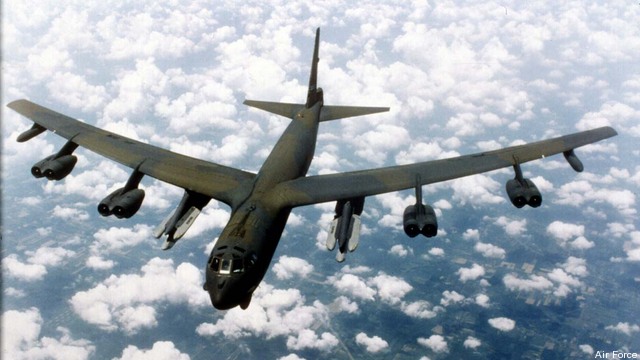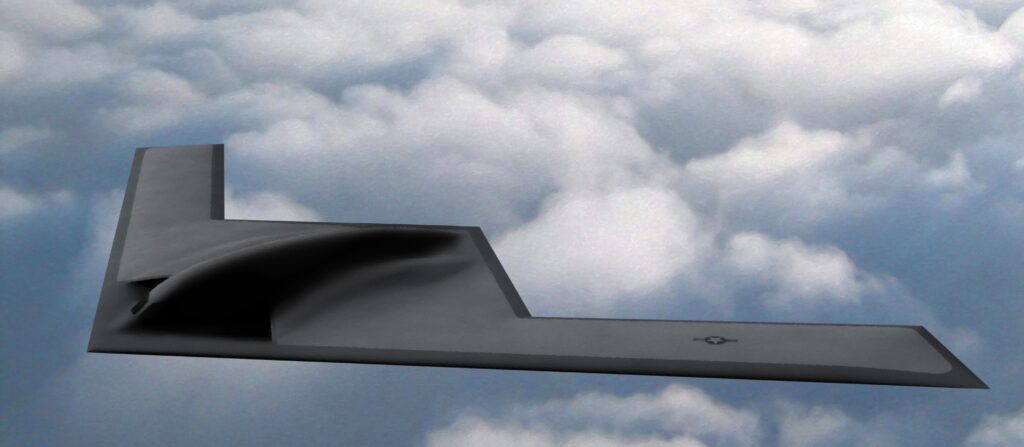No $ For New B-52 Engines Til 2020; Nuke Modernization Moves Ahead: Gen. Rand
Posted on
CORRECTED: Inserted Photo Of Minuteman III; Removed Photo Of Titan
WASHINGTON: Gen. Robin Rand, the Air Force bomber and missile boss, really wants new jet engines for his aging B-52s. The service has invited interested companies to a two-day information session in December and Boeing and Rolls-Royce are already publicly campaigning for the contract. But, Rand told reporters at the Association of Old Crows conference here, the project won’t be funded before the 2020 budget at best.
The actual delivery and installation of new engines on the service’s 76 1952-vintage B-52H bombers will, of course, take years after that. The project will have to fit in the budget at the same time as the Air Force’s new B-21 bomber and new ICBM, as well as a new Navy missile submarine.

Gen. Robin Rand
Re-engining the B-52 is “on the table, I feel positive, but I’m not going to try to hem in the chief or secretary,” Gen. Rand said. “We’re still deciding.”
That said, “I think we’re closer to getting a decision on re-engining than any time that I’ve been (involved),” Rand emphasized. “I think we’ve made a compelling case that the B-52’s going to be around, and it warrants being re-engined.”
Part of building that case is the unclassified industry day — strictly, two days: Dec. 12-13 — being held at Barksdale Air Force Base in Louisiana. The official announcement emphasizes the Air Force is just asking for information, not formal proposals, and it’s not committed to buying anything, although it does outline the service’s preferred contracting structure.
Industry is definitely excited. In August, Boeing posted a five-and-a-half-minute animation on YouTube touting its approach to re-engining (see the top of this story). In September, Roll-Royce executive Tom Hartmann told our colleagues at Flight Global that “we’re acting like it’s imminent.”
It’s not. “This is all part of the FY ’20 planning choices,” Rand said. In the ponderous budget process, Congress is currently struggling to pass proper spending bills for fiscal year 2018 — which began two months ago — while the administration is already finalizing the request for 2019, which will be submitted early next year. Re-engining is on the table for the budget after that, Rand made clear: “That decision hasn’t been made. It won’t be earlier than ’20 if it happens.”
UPDATE: Veteran aviation analyst Richard Aboulafia was skeptical the re-engining would ever happen. “It’s such a great idea — a great idea for the past 30+ years now — and probably doomed, like many great ideas,” he told me. The Pentagon’s budget process makes it an uphill battle.
“The problem is that re-engining would save money from the O&M account (fuel and parts) and would cost money from the procurement account,” Aboulafia explained. “Yes, the O&M savings would quickly outweigh the procurement cost, but the two budgets don’t speak. Savings from O&M aren’t used to replace the spent procurement cash stream. It’s a goofy way to do accounting, but I’m afraid DoD is stuck with it.”
“That’s why planes don’t get re-engined,” he said. “The only exceptions were the KC-135 (around 2,000 engines…that moves the needle fast!) and the C-5A, whose TF39 motors were troubled orphans that suffered from low readiness and diminishing spares supplies.”

B-52H Stratofortress
Missiles & Bombers
Besides potentially re-engining the B-52, 2020 will see another big decision for Rand’s Global Strike Command: whether to contract with Boeing or Northrop Grumman to build a new ICBM to replace the aging Minuteman III. (In August, each company got a $300-plus million contract for Technology Maturation and Risk Reduction, while Lockheed’s proposal was rejected). The final price-tag of this Ground-Based Strategic Deterrent (GBSD) is in flux, but the Pentagon’s independent Cost Assessment & Program Evaluation (CAPE) office estimates the price tag will be at least $85 billion.

Minuteman III in silo
It’s not just about the missile, Rand told reporters. GBSD will change “how we secure the weapons, how we command and control the weapons — there’s a lot of things,” he said. Those changes will flow in part from the winning contractor’s approach, however, so it’s premature to say what they would be.
Meanwhile, the Air Force is also replacing its 1980s-vintage Air-Launched Cruise Missile, another aging nuclear weapon. In August, the service awarded “approximately $900 million” contracts to develop prototype Long-Range Stand Off (LRSO) missiles to Lockheed Martin and to Raytheon, with a final winner to be selected in 2022. If anti-nuke Democrats don’t kill it, the LRSO will go on the B-52, the B-2 stealth bomber, and the still-in-development B-21.
The service intends to buy at least 100 B-21 bombers for $550 million apiece. To achieve that ambitious cost target, the program was put under the Air Force Rapid Capabilities Office (RCO) rather than the standard acquisition bureaucracy. Overseeing the B-21 requires as many RCO personnel as all the office’s other projects put together, office director Randall Walden told the Old Crows conference.
The B-21 is by far the biggest mystery in Global Strike Command. Since the Air Force awarded the contract for the new stealth bomber to Northrop Grumman just over two years ago, it’s been extremely secretive about the project, essentially releasing the official designation and nickname — B-21 Raider — and deliberately low-detail CGI artwork. The service has said the aircraft would be optionally unmanned, capable of carrying a huge bomb load, eventually be certified for nuclear weapons, and carry modular packages of ISR and Electronic Warfare sensors. Since Gen. Rand was speaking to a conference on electronic warfare, I pressed him on the rumored EW capabilities being built into the B-21 to permit it to penetrate advanced anti-aircraft defenses. He wouldn’t discuss any details, but he did explain the philosophy.

B-21 Raider artist rendering
The B-21 will be “a family of systems,” not just a single aircraft, Rand told the conference. “It’s not going to go in alone and armed and unafraid, but we’re not going to talk about what those capabilities are here.”
“The B-21, with other assets, (is) going to be able to do what we (need) in a contested environment,” Rand told reporters afterwards.
“It’s going to be a very sensor-centric platform,” he said — that is, the radar and other sensors will be as important as the weapons, as is the case for the F-35 Joint Strike Fighter. “It’s a long range strike (aircraft) that will have standoff and penetration capability,” he said — that is, it can either fire long-range cruise missiles from outside the range of the enemy’s anti-aircraft weapons, or it can slip through the air defenses by using both stealth and electronic deception.
The so-called Anti-Access/Area Denial defenses that Russia and China are constructing will have weak points the B-21 can exploit, Rand said. “Everyone talks A2/AD like it’s this block of wood that’s impenetrable. I want to tell you that A2/AD is like a chunk of cheese, and it’s Swiss cheese… it has holes.”
Subscribe to our newsletter
Promotions, new products and sales. Directly to your inbox.
